For patients and employees, a functional lighting system is crucial. Lighting in healthcare facilities for staff members must satisfy the needs of the visual task, including those for exams, care and service, and laboratory tasks. The lighting in the patient's room should be up to code and individually adjustable to ensure that the patient is comfortable. Additionally, it should be simple and quick to manage the illumination. Here, straightforward, self-explanatory operating systems are beneficial. Even while special features may not be evident to the user immediately, building services benefit greatly. Some of them include integrated power measurement, system analysis, operational hours counters, and status reporting.
Large hospitals and nursing homes are constantly busy. In addition to medical equipment, a significant cost component is lighting by adjusting light output as needed through voice commands or remote switches to improve comfort and safety while lowering long-term energy expenditures.
Evvr is the trusted partner of both people and businesses to provide intelligent solutions for better living and working. If you want to overhaul the lighting of your healthcare facility by swapping it with modern hardware, Evvr is the best option in the market!
- Benefits of Good LED Lighting In Healthcare
- Factors In Designing & Developing Hospital Lighting
- Evvr In-Wall Relay Switch - The Magic Switch
Benefits of Good LED Lighting In Healthcare
For the comfort of patients and the precision of healthcare personnel, the healthcare sector needs clear, bright illumination. Healthcare facilities must, however, be mindful of the cost of their lighting solutions due to ever-shrinking budgets and environmental considerations. LED lighting options provide the best solution for balancing both needs. LED lighting offers healthcare organizations various advantages with its bright, clear lighting that is economical and environmentally beneficial. Here are a few benefits of incorporating LED-based intelligent lighting solutions in healthcare facilities.

Compatible With Body’s Circadian Rhythm
The circadian rhythm is a natural rhythm that the human body has. Based on the color of the light, the body may naturally release the hormones needed for activity and sleep. The light is a warm, white tint in the morning and evening, and melatonin is naturally released by the body to make one fall asleep. Bright, cooler light during the day causes the body to naturally produce more serotonin and less melatonin, which primes it for activity.
The light that resembles the bright, cold light of the midday sun in a hospital setting encourages staff and patients to be more awake as they do their business. Due to the lights not producing melatonin, this can reduce tiredness. On the other hand, employees may become drowsy if the lighting at a hospital is warm, like with different types of lighting. Their work may become more challenging as a result. LED lighting is an excellent white light that promotes worker accuracy and alertness.
>> Using Smart hospital technology to create hospital automation
Improved Color Accuracy Leads To True Diagnoses
Visual examinations of patients are required of healthcare workers. The initial visual assessment is used to diagnose a significant number of the conditions that are treated in an institutional setting such as a hospital or clinic. For instance, the color of a patient's skin is typically the first thing that is seen while diagnosing jaundice. Because of this, medical care places require lighting with a high color rendering index, also known as CRI. LED lighting provides a CRI that is as near as feasible to that of natural sunshine, which improves the precision of work performed in a healthcare setting.
Cost-Effective Solution
The lights are required to be on continuously in various types of healthcare facilities, such as hospitals. The lighting provider will have a better financial situation if the lighting is energy efficient. Smart LED lighting can reduce energy costs by as much as 80 percent, sometimes even more. This does not include the additional savings on the HVAC system that can be achieved due to the reduced heat produced by LED lighting.
Bright lights that can be operated remotely via a smartphone application or voice command can save a lot of money for the hospital without affecting the patient experience. Evvr offers control units, bridges, and appliances to create an intelligent space at your hospital.
Factors In Designing & Developing Hospital Lighting
Lighting impacts all facets of the human experience, and when appropriately used in a medical setting, it can improve patient comfort and promote recovery. We have vast expertise in providing the complicated, high-quality lighting solutions required to support the plethora of jobs being performed in various sectors, ranging from operating rooms to nursing stations, wards to public spaces, as specialists in lighting for healthcare.
Pleasant Ambiance
To improve patients' well-being, light is crucial. According to studies, a well-designed lighting system can shorten stay times while reducing medical errors, patient falls, discomfort, stress, and sadness. A thoughtfully planned environment in the wards, hallways, and other hospital areas also improves personnel working conditions, boosting productivity and satisfaction.
Giving patients more control over their surroundings is also regarded as advantageous. That's why many hospitals install color-changing LED uplights in pediatric patient rooms so kids can pick the light color in their rooms. To give clues and aid in settling the young patients at night, they also program changes in daylight level adjustments into the lighting management system.
Sunlight - Brighter & Healthier
It is believed that patients with access to natural light will require less medication and a shorter period to recover from their illness. Top healthcare facilities perform daylighting modeling to maximize the availability of natural light, such as sunlight, inpatient rooms, waiting rooms, staff work rooms, and rest areas. In areas with insufficient daylight, they compensate by providing lighting solutions that simulate natural lighting conditions throughout the day to support the circadian rhythm.

>> How smart home tech can help you avoid viruses
Better Lighting For Critical Areas
Operating rooms must have illumination that is both specialized and of a high-performance level to treat patients safely. For doctors to accurately diagnose their patients' conditions, accurate color rendering is essential, much as the appropriate light intensity is necessary to perform delicate and thorough surgical procedures. The selection of fixtures that can maintain the highest possible standards of cleanliness is another essential factor to take into account. LED lighting encased in plastic housings, with the drivers and transformers housed outside the room, is a component of specialized lighting schemes designed for other highly technical environments, such as MRI suites, in which ferrous materials are not permitted use.
Low Maintenance, More Efficiency
Lighting accounts for at least ten percent of a healthcare facility's total energy usage and, as a result of the heat it generates, increases the amount of cooling that is required. Therefore, there is a significant potential for financial and environmental savings that can be realized through the use of lighting strategies that are energy efficient. We insist on lighting solutions that are efficient in terms of cost and can be maintained over an extended time. These include using light-emitting diodes (LEDs) wherever they are suitable and making the most of the available natural light by installing daylighting controls in portions of the house with many windows.
Occupancy sensors are one example of the sophisticated control measures that contemporary medical facilities implement to reduce their overall energy usage. These facilities are designed to meet the stringent requirements of modern medicine.
Evvr In-Wall Relay Switch - The Magic Switch
Incorporating intelligent solutions in your hospitals, such as lights and bulbs, should be a hassle. Evvr is your partner in turning old switches into smart ones via Evvr In-Wall Relay Switch. Through this, you can control lights via innovative applications or voice commands. Patients will be in control of their surroundings when they can turn a light on and off on their own. It is a no-neutral switch that is a breeze to install and run. Evvr can offer you a comprehensive smart home solution whether you are an integrator, professional installer, distributor, or DIYer. Get in touch with us and become our partner today!












